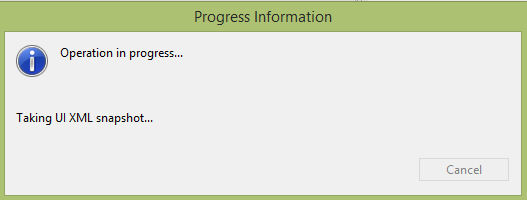- Android中的响应式UI设计
- Android中的响应式UI设计(1)
- Android UI 设计中的布局
- Android UI 设计中的布局(1)
- Android中的仪表板UI设计
- Android中的仪表板UI设计(1)
- 设计课(1)
- 设计课
- 设计课
- 设计课(1)
- 设计课
- Android-UI测试(1)
- Android-UI测试
- Android-UI模式
- Android-UI模式(1)
- 语义-UI 图标集设计(1)
- 语义-UI 图标集设计
- ui (1)
- 设计问题(1)
- 设计问题
- 在 android 中设计自定义按钮 - Java 代码示例
- Android UI 布局
- Android-UI布局(1)
- Android UI 布局(1)
- Android-UI布局
- Android中的材料设计简介(1)
- Android中的材料设计简介
- 如何使用 jQuery UI 设计颜色选择器?
- 如何使用 jQuery UI 设计颜色选择器?(1)
📅 最后修改于: 2021-01-05 05:37:40 🧑 作者: Mango
在本章中,我们将介绍android屏幕的不同UI组件。本章还介绍了进行更好的UI设计的技巧,并说明了如何设计UI。
UI屏幕组件
android应用程序的典型用户界面由操作栏和应用程序内容区域组成。
- 主动作栏
- 视图控件
- 内容区
- 拆分动作栏
这些组件也显示在下图中-

了解屏幕组件
android应用程序的基本单元是活动。 UI在xml文件中定义。在编译期间,将XML中的每个元素编译为等效的Android GUI类,其类具有由方法表示的属性。
视图和视图组
活动由视图组成。视图只是出现在屏幕上的小部件。可以是按钮,也可以将一个或多个视图组合到一个GroupView中。 ViewGroup的示例包括布局。
布局类型
有很多类型的布局。下面列出其中一些-
- 线性布局
- 绝对布局
- 桌子布局
- 框架布局
- 相对布局
线性布局
线性布局又分为水平和垂直布局。这意味着它可以在单列或单行中排列视图。这是包含文本视图的线性布局(垂直)代码。
绝对布局
AbsoluteLayout使您可以指定其子级的确切位置。可以这样声明。
表格布局
TableLayout将视图分为行和列。可以这样声明。
相对布局
RelativeLayout使您可以指定子视图之间的相对位置。可以这样声明。
框架布局
FrameLayout是屏幕上的占位符,可用于显示单个视图。可以这样声明。
除了这些属性外,在所有视图和ViewGroups中还有其他公共属性。它们在下面列出-
| Sr.No | View & description |
|---|---|
| 1 |
layout_width Specifies the width of the View or ViewGroup |
| 2 |
layout_height Specifies the height of the View or ViewGroup |
| 3 |
layout_marginTop Specifies extra space on the top side of the View or ViewGroup |
| 4 |
layout_marginBottom Specifies extra space on the bottom side of the View or ViewGroup |
| 5 |
layout_marginLeft Specifies extra space on the left side of the View or ViewGroup |
| 6 |
layout_marginRight Specifies extra space on the right side of the View or ViewGroup |
| 7 |
layout_gravity Specifies how child Views are positioned |
| 8 |
layout_weight Specifies how much of the extra space in the layout should be allocated to the View |
测量单位
在Android UI上指定元素的大小时,应记住以下度量单位。
| Sr.No | Unit & description |
|---|---|
| 1 |
dp Density-independent pixel. 1 dp is equivalent to one pixel on a 160 dpi screen. |
| 2 |
sp Scale-independent pixel. This is similar to dp and is recommended for specifying font sizes |
| 3 |
pt Point. A point is defined to be 1/72 of an inch, based on the physical screen size. |
| 4 |
px Pixel. Corresponds to actual pixels on the screen |
屏幕密度
| Sr.No | Density & DPI |
|---|---|
| 1 |
Low density (ldpi) 120 dpi |
| 2 |
Medium density (mdpi) 160 dpi |
| 3 |
High density (hdpi) 240 dpi |
| 4 |
Extra High density (xhdpi) 320 dpi |
优化布局
以下是一些有关创建有效布局的准则。
- 避免不必要的嵌套
- 避免使用过多的视图
- 避免深层嵌套